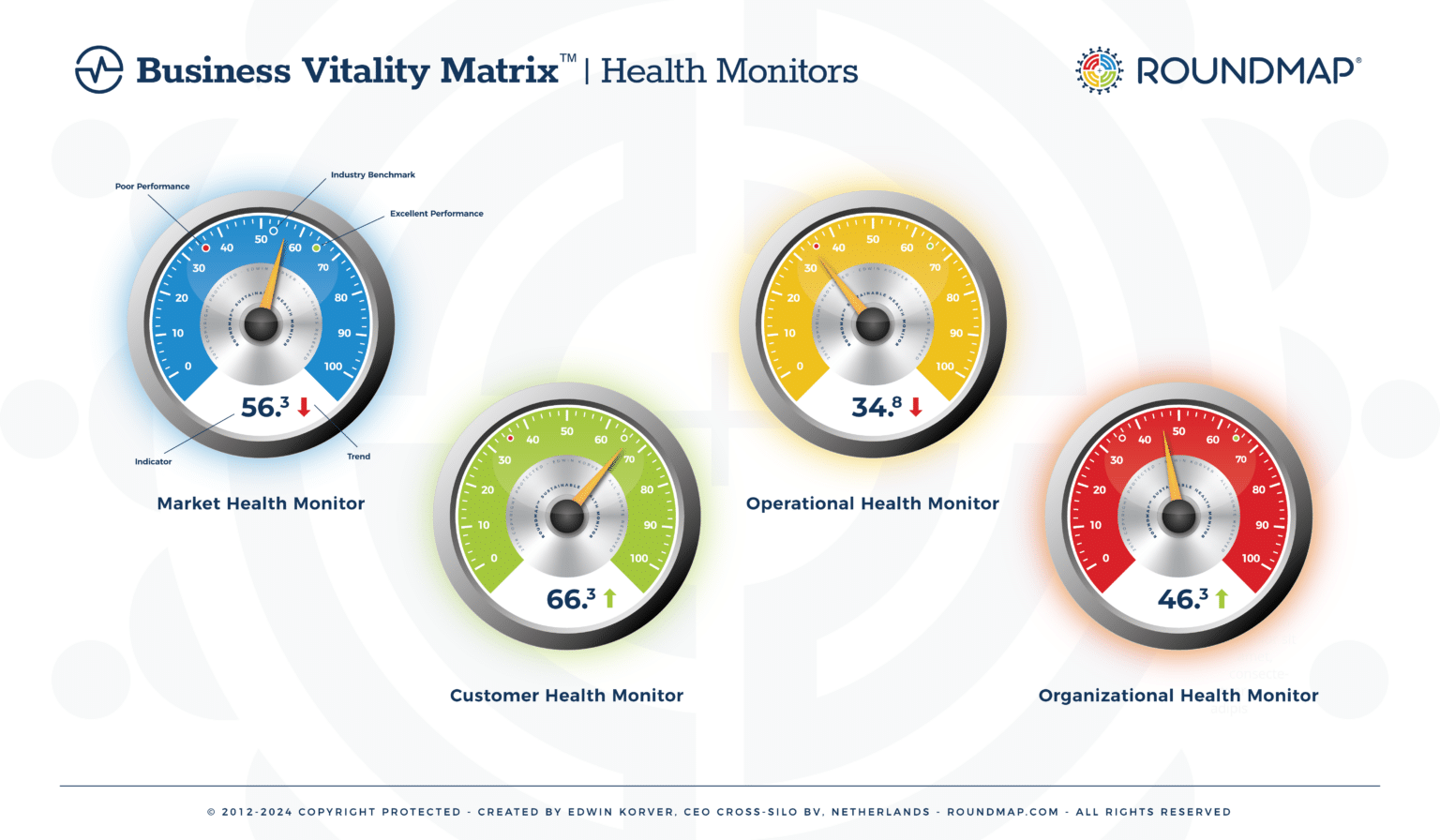In the dynamic theater of business, strategic frameworks act as choreographers guiding companies toward success. Michael Porter’s value chain theory, a timeless composition, dissects operations into primary and support activities, illuminating the components that generate competitive advantage. A symphony of insight, the Sustainable Health Monitors, born in 2018, aligns with this theory, focusing on Market, Customer, Operational, and Organizational health.
Porter's Value Chain Theory
At its core, Porter’s value chain theory dissects a company’s operations into two categories: primary activities that directly contribute to the creation and delivery of a product or service, and support activities that facilitate the efficiency and effectiveness of the primary activities. This theory illuminates the critical components that generate value and differentiates a company within its industry.
Sustainable Health Monitors: A Symphony of Insight
- Market Health Monitor:
- Examines the external forces shaping the market landscape.
- Questions: How are industry trends evolving? What is the competitive terrain?
- Customer Health Monitor:
- Measures customer satisfaction, loyalty, and engagement.
- Questions: Are customers delighted with our offerings? What feedback are they sharing?
- Operational Health Monitor:
- Evaluates the efficiency and effectiveness of internal processes.
- Questions: How streamlined are our operations? Are there bottlenecks hindering progress?
- Organizational Health Monitor:
- Assesses the overall health of the company, encompassing culture and leadership.
- Questions: What is the morale among employees? Is the leadership fostering innovation and collaboration?
Integration into the Business Vitality Matrix
These monitors integrate seamlessly into the Business Vitality Matrix™, a tool categorizing companies into four states:
- Nascent: Explorers with a focus on exploration and innovation.
- Stagnant: Opportunists adapting to market trends for short-term gains.
- Stable: Stewards with a steady foothold, balancing innovation and stability.
- Constraint: Architects planning for long-term sustainability.
Navigating the Landscape
- Nascent Explorers: Explorers venture into uncharted territory. The monitors help them navigate market dynamics, ensuring their path aligns with their innovative spirit.
- Stagnant Opportunists: Opportunistic companies ride the waves of market trends. Monitors alert them to shifts, allowing them to capitalize on opportunities and navigate risks.
- Stable Incumbents: Stewards balance stability and innovation. Monitors act as stabilizers, ensuring they stay ahead while maintaining their established position.
- Constraint Architects: Architects meticulously design for long-term sustainability. The monitors serve as blueprints, ensuring their plans are resilient to external shifts.
Key Performance Indicators per Health Indicator
Key Performance Indicators (KPIs) for each of the four Sustainable Health Monitors can help you measure and track the health of your business across different dimensions. Here are suggested KPIs for each monitor:
- Market Health Monitor:
- Customer Acquisition Cost (CAC): Measure the cost of acquiring a new customer, providing insights into the efficiency of your marketing and sales efforts.
- Market Share: Understand the percentage of the total market that your business occupies, indicating your competitiveness.
- Net Promoter Score (NPS): Assess customer satisfaction and loyalty, helping gauge your brand’s health in the market.
- Trend Analysis: Monitor market trends and changes, staying ahead of industry shifts.
- Market Health Monitor:
2. Customer Health Monitor:
- Customer Satisfaction (CSAT) Score: Measure the overall satisfaction of your customers with your products or services.
- Customer Retention Rate: Track the percentage of customers who continue to use your products or services over time.
- Customer Lifetime Value (CLV): Evaluate the total revenue a business can reasonably expect from a single customer.
- Feedback and Reviews: Collect and analyze customer feedback and reviews to understand sentiment and areas for improvement.
3. Operational Health Monitor:
- Cycle Time: Measure the time it takes to complete a process, helping identify and eliminate bottlenecks.
- Resource Utilization: Assess the efficiency of resource allocation and utilization within your operations.
- Error Rate: Track the frequency of errors or defects in processes to identify areas for improvement.
- Supply Chain Efficiency: Evaluate the efficiency of your supply chain processes, ensuring timely delivery and cost-effectiveness.
4. Organizational Health Monitor:
- Employee Satisfaction and Engagement: Measure the satisfaction and engagement levels of your employees.
- Leadership Effectiveness: Assess the effectiveness of leadership in guiding the organization toward its goals.
- Innovation Index: Track the level of innovation within the organization, indicating its ability to adapt and evolve.
- Culture and Diversity Metrics: Evaluate the organizational culture and diversity to ensure a positive and inclusive workplace.
These KPIs can serve as a starting point, and you may customize them based on your specific business goals, industry, and the nature of your operations. Regularly monitoring these indicators will provide valuable insights into the health of your business across the market, customers, operations, and organization.
A Holistic Symphony of Success
The Sustainable Health Monitors and the Business Vitality Matrix, a harmonious duet, provide real-time notes on a company’s health. Together, they guide businesses through different states, adapting their strategies to stay in tune with the ever-changing business landscape.
In the orchestra of business, each instrument plays a crucial role. The integration of Sustainable Health Monitors and the Business Vitality Matrix orchestrates success, ensuring that companies not only survive but thrive in the symphony of the corporate world.
Author
-
Edwin Korver is a polymath celebrated for his mastery of systems thinking and integral philosophy, particularly in intricate business transformations. His company, CROSS/SILO, embodies his unwavering belief in the interdependence of stakeholders and the pivotal role of value creation in fostering growth, complemented by the power of storytelling to convey that value. Edwin pioneered the RoundMap®, an all-encompassing business framework. He envisions a future where business harmonizes profit with compassion, common sense, and EQuitability, a vision he explores further in his forthcoming book, "Leading from the Whole."
View all posts Creator of RoundMap® | CEO, CROSS-SILO.COM






